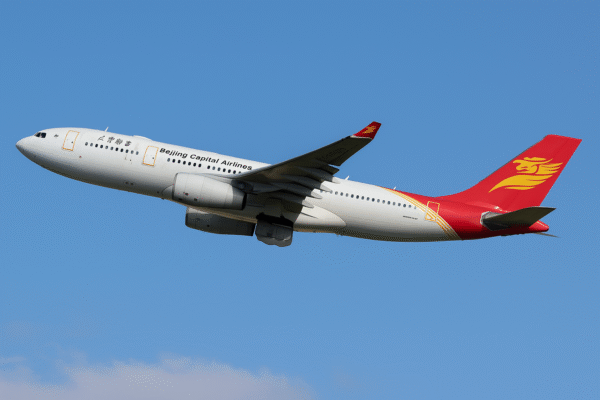The European aviation sector is off to a flying start in 2025, with passenger traffic rising across both major and regional airports. According to the latest Airports Council International Europe (ACI Europe) report, the first half of the year saw robust growth in countries including the UK, Italy, France, Poland, Denmark, Malta, Spain, Turkey, Hungary, and Greece.
Greece stood out with a 5.3% nationwide increase in airport passenger numbers compared to the same period in 2024 — a testament to its growing tourism appeal and enhanced connectivity.
Greek Airports Take the Spotlight
Three Greek airports — Athens International Airport, Syros Island Airport (JSY), and Volos Airport (VOL) — emerged as top performers in European traffic growth.
- Athens International Airport posted a 7.6% increase in passenger volume, matching the growth rate of Copenhagen Airport and underscoring Athens’ strength as a major tourism and business hub.
- Syros Island Airport saw a staggering 112.8% jump, more than doubling its passenger count compared to last year, thanks to targeted airline partnerships and new seasonal routes.
- Volos Airport experienced 51.1% growth, reflecting the rising popularity of Greece’s lesser-known destinations.
These figures show that Greek tourism is spreading beyond iconic hubs like Santorini and Mykonos toward more authentic, off-the-beaten-path locations.
Milan Malpensa Leads Major Airport Growth
Among Europe’s large hubs, Milan Malpensa Airport delivered the most impressive growth with an 11.4% surge, solidifying its position as a gateway for both leisure and business travelers. Manchester Airport in the UK followed with 5.3%, while Paris Orly reported a 5% rise.
While flagship airports such as London Heathrow and Amsterdam Schiphol posted slower gains — 0.2% and 3% respectively — secondary and emerging hubs are increasingly capturing traffic as travelers seek alternative routes and airlines diversify their networks.
International Travel Fuels Growth
Overall, European passenger traffic rose by 4.5% in the first six months of 2025 compared to the same period in 2024. The key driver? International travel, which jumped 5.7% year-on-year, outpacing the flat 0.2% growth in domestic travel.
Notably, total passenger volumes are now 5.1% higher than pre-pandemic levels (H1 2019), confirming that the sector has not only recovered but expanded beyond previous records.
Regional Airports Outperform
Medium and regional airports delivered some of the most remarkable statistics:
- Tel Aviv Airport (+27%)
- Krakow (+18.7%)
- Budapest (+15%)
- Warsaw (+13.2%)
These hubs are benefitting from new low-cost carrier routes, seasonal tourism spikes, and increased long-haul connectivity.
Smaller airports (under 1 million passengers annually) also grew by 5.1%, though they remain 32.9% below pre-2019 levels, highlighting the uneven pace of recovery.
Country-by-Country Highlights
- Slovakia leads with +19.2% passenger growth, followed by Poland (+14.9%), Hungary (+14.2%), Malta (+11.7%), and Cyprus (+10.8%).
- In Southern Europe, Italy registered +5.7% growth, driven by strong domestic demand and inbound tourism, while Spain rose +4.5%.
- France, UK, and Germany posted steady but slower increases between +2.3% and +3.6%.
- Outside the EU, Moldova saw a record +49.2% rise, Bosnia & Herzegovina climbed +31.1%, and Israel grew +27%, showing resilience despite regional challenges.
Why Regional Airports Are Winning
ACI Europe’s data points to three main factors driving regional airport growth:
- Shift in Traveler Preferences — Tourists are increasingly drawn to smaller cities and coastal towns, avoiding crowded hubs.
- Airline Strategy — Carriers are deploying more direct routes to secondary airports to reduce congestion at major hubs.
- Tourism Diversification — Governments and tourism boards are actively promoting lesser-known destinations.
For example, Greece’s promotion of island-hopping itineraries that include Syros and Volos is clearly paying off.
Economic and Tourism Implications
The surge in passenger traffic is not just a travel trend — it’s an economic boost. Increased air connectivity fuels local hospitality industries, retail sectors, and cultural attractions.
In Greece alone, the rise in regional airport traffic is expected to contribute significantly to off-season tourism, helping extend the visitor economy beyond the traditional summer months.
Outlook for 2025 and Beyond
With international travel demand strong and tourism boards pushing aggressive marketing campaigns, Europe’s aviation sector is set for continued growth in 2025.
Emerging hubs in Central and Eastern Europe will likely keep outpacing traditional Western European gateways, while Mediterranean countries — especially Greece, Italy, and Spain — remain the backbone of leisure travel demand.
However, capacity constraints at major hubs, sustainability regulations, and geopolitical uncertainties could shape the trajectory of the second half of the year.
Conclusion:
Europe’s aviation map is shifting. While global gateways like Heathrow, Charles de Gaulle, and Schiphol remain vital, the real growth story of 2025 lies in regional airports and emerging hubs. From Syros’ triple-digit surge to Milan Malpensa’s double-digit gains, the data shows a vibrant, resilient, and diversified European air travel market.
For more travel news like this, keep reading Global Travel Wire














